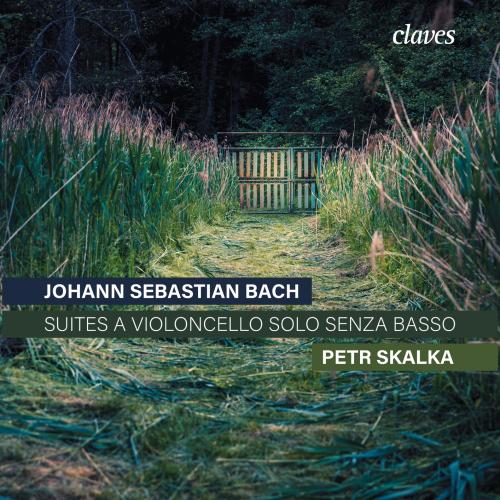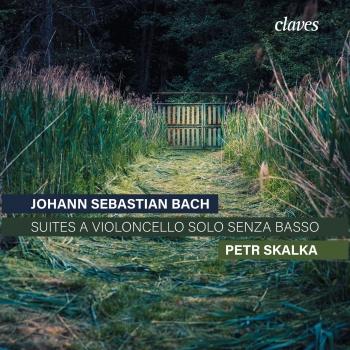
6 Suites a Violoncello solo senza Basso Petr Skalka
Album info
Album-Release:
2024
HRA-Release:
09.02.2024
Label: Claves Records
Genre: Classical
Subgenre: Instrumental
Artist: Petr Skalka
Composer: Johann Sebastian Bach (1685–1750)
Album including Album cover Booklet (PDF)
- Petr Skalka: Initio:
- 1 Skalka: Initio: Improvisation 00:57
- Johann Sebastian Bach (1685 - 1750): Suite No. 1 in G Major BWV 1007:
- 2 Bach: Suite No. 1 in G Major BWV 1007: I. Prelude 02:26
- 3 Bach: Suite No. 1 in G Major BWV 1007: II. Allemande 05:02
- 4 Bach: Suite No. 1 in G Major BWV 1007: III. Courante 03:18
- 5 Bach: Suite No. 1 in G Major BWV 1007: IV. Sarabande 03:19
- 6 Bach: Suite No. 1 in G Major BWV 1007: V. Menuet I-II 04:03
- 7 Bach: Suite No. 1 in G Major BWV 1007: VI. Gigue 01:38
- Suite No. 2 in D Minor BWV 1008:
- 8 Bach: Suite No. 2 in D Minor BWV 1008: I. Prelude 04:09
- 9 Bach: Suite No. 2 in D Minor BWV 1008: II. Allemande 04:48
- 10 Bach: Suite No. 2 in D Minor BWV 1008: III. Courante 02:02
- 11 Bach: Suite No. 2 in D Minor BWV 1008: IV. Sarabande 04:16
- 12 Bach: Suite No. 2 in D Minor BWV 1008: V. Menuet I-II 04:02
- 13 Bach: Suite No. 2 in D Minor BWV 1008: VI. Gigue 02:53
- Suite No. 3 in C Major BWV 1009:
- 14 Bach: Suite No. 3 in C Major BWV 1009: I. Prelude 03:43
- 15 Bach: Suite No. 3 in C Major BWV 1009: II. Allemande 04:22
- 16 Bach: Suite No. 3 in C Major BWV 1009: III. Courante 04:13
- 17 Bach: Suite No. 3 in C Major BWV 1009: IV. Sarabande 04:03
- 18 Bach: Suite No. 3 in C Major BWV 1009: V. Bourrée I-II 03:47
- 19 Bach: Suite No. 3 in C Major BWV 1009: VI. Gigue 03:14
- Heinrich Ignaz Franz Biber (1644 - 1704): Passacaglia for solo cello in C Minor "The Guardian Angel", after the original for violin from the Rosary Sonatas, arr. by Petr Skalka:
- 20 Biber: Passacaglia for solo cello in C Minor "The Guardian Angel", after the original for violin from the Rosary Sonatas, arr. by Petr Skalka 09:52
- Johann Sebastian Bach: Suite No. 4 in E-Flat Major BWV 1010:
- 21 Bach: Suite No. 4 in E-Flat Major BWV 1010: I. Prelude 03:50
- 22 Bach: Suite No. 4 in E-Flat Major BWV 1010: II. Allemande 04:51
- 23 Bach: Suite No. 4 in E-Flat Major BWV 1010: III. Courante 03:47
- 24 Bach: Suite No. 4 in E-Flat Major BWV 1010: IV. Sarabande 04:01
- 25 Bach: Suite No. 4 in E-Flat Major BWV 1010: V. Bourrée I-II 04:48
- 26 Bach: Suite No. 4 in E-Flat Major BWV 1010: VI. Gigue 02:40
- Suite No. 5 in C Minor BWV 1011:
- 27 Bach: Suite No. 5 in C Minor BWV 1011: I. Prelude 04:58
- 28 Bach: Suite No. 5 in C Minor BWV 1011: II. Allemande 05:31
- 29 Bach: Suite No. 5 in C Minor BWV 1011: III. Courante 02:18
- 30 Bach: Suite No. 5 in C Minor BWV 1011: IV. Sarabande 03:26
- 31 Bach: Suite No. 5 in C Minor BWV 1011: V. Gavotte I-II 05:29
- 32 Bach: Suite No. 5 in C Minor BWV 1011: VI. Gigue 01:58
- Suite No. 6 in D Major BWV 1012:
- 33 Bach: Suite No. 6 in D Major BWV 1012: I. Prelude 04:14
- 34 Bach: Suite No. 6 in D Major BWV 1012: II. Allemande 07:20
- 35 Bach: Suite No. 6 in D Major BWV 1012: III. Courante 04:01
- 36 Bach: Suite No. 6 in D Major BWV 1012: IV. Sarabande 04:15
- 37 Bach: Suite No. 6 in D Major BWV 1012: V. Gavotte I-II 04:47
- 38 Bach: Suite No. 6 in D Major BWV 1012: VI. Gigue 04:22
Info for 6 Suites a Violoncello solo senza Basso
With these words begins the first written cello method, authored by Michel Corrette and published in Paris around 1741: the cello, a bass instrument, is considered a “noble pillar of harmony”. At that time, music history was roughly in the middle of the basso continuo era, which began during Monteverdi’s lifetime with the “Seconda Pratica” and ended during Robert Schumann’s lifespan. A lot revolved around the melody of the bass line, its realisation and rendering. In Corelli’s orchestra, a large bass section comprising many instruments of different sizes, with several cellos, double basses, lutes and harpsichords, was placed just behind the concertino. Behind them were the intermediate voices, first and second violas. Only behind the latter were those who carried the melody of the upper voices, namely the violinists. Such a setting has nothing to do with today’s musical practice and sound expectations. The vast bass section determined the tempo, the character and the dynamics. Those providing the melody had to adapt; any resistance would have been pointless.
With this in mind, the title page of J. S. Bach’s Cello Suites may seem revolutionary at first glance: “6 Suites a Violoncello solo senza basso”. A musical work dedicated to an important instrument, the pillar of harmony, but “senza basso”, without bass! And this in an age in which there could be no music without bass, given the compositional method and practice of the basso continuo! In reality, the bass is clearly present in these solo suites. The designation “senza basso” is intended to warn the performer that there is no point in leafing through the pages of the score in search of the bass line. The bass is, in fact, already present in the monophonic solo part. [..]
Petr Skalka, cello
Petr Skalka
was born in the Czech Republic and studied violoncello at the Pilsen Music Conservatory in West Bohemia. It was his interest in early music and historical performance practice that moved him to additional specific studies in early music. Subsequently, he studied baroque cello and historical performance practice with the French cellist Christophe Coin at the Schola Cantorum Basiliensis, where he graduated in 1999.
Since 2001, he has assisted Christophe Coin at the Schola Cantorum Basiliensis and also taught baroque cello at the Hochschule für Musik Nuremberg from 2011-2015.
As a respected musician, Petr Skalka enjoys the privilege of performing regularly with renowned chamber ensembles and musicians throughout Europe and in well-known concert halls. Some of his recordings with the ensembles Café Zimmermann and Rincontro have received editorial awards.
Booklet for 6 Suites a Violoncello solo senza Basso










